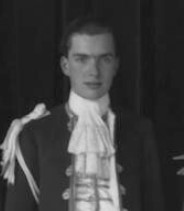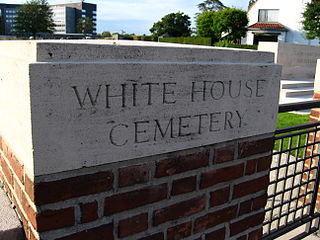
Edward Donald Slovik was a United States Army soldier during World War II and the only American soldier to be court-martialled and executed for desertion since the American Civil War. Although over 21,000 American soldiers were given varying sentences for desertion during World War II, including 49 death sentences, Slovik's death sentence was the only one that was carried out.

Execution by firing squad, in the past sometimes called fusillading, is a method of capital punishment, particularly common in the military and in times of war. Some reasons for its use are that firearms are usually readily available and a gunshot to a vital organ, such as the brain or heart, most often will kill relatively quickly.

Cowardice is a trait wherein excessive fear prevents an individual from taking a risk or facing danger. It is the opposite of courage. As a label, "cowardice" indicates a failure of character in the face of a challenge. One who succumbs to cowardice is known as a coward.

Desertion is the abandonment of a military duty or post without permission and is done with the intention of not returning. This contrasts with unauthorized absence (UA) or absence without leave, which are temporary forms of absence.

George Alexander Eugene Douglas Haig, 2nd Earl Haig, was a British artist and peer who succeeded to the earldom of Haig on 29 January 1928, at the age of nine upon the death of his father, Field Marshal the 1st Earl Haig. Until then he was styled Viscount Dawick. Throughout his life, he was usually known to his family and friends as Dawyck Haig.

Ernest Thurtle was a British Labour politician.
Eric Skeffington Poole was a British Army soldier who was the first commissioned officer to be executed by British military authority during World War I.
Victor Manson Spencer was a volunteer from Invercargill, New Zealand who fought in the Otago Infantry Regiment of the New Zealand Division in World War I. Spencer was executed for desertion on 24 February 1918, despite later suggestions that he was severely traumatised by shellshock, having fought and survived several campaigns.

Capital punishment in Finland has been abolished de jure.
Private Harry T. Farr was a British soldier who was executed by firing squad during World War I for cowardice at the age of 25. Before the war, he lived in Kensington, London and joined the British Army in 1908. He served until 1912 and remained in the reserves until the outbreak of World War I. During the war, Farr served with the West Yorkshire Regiment on the Western Front. In 1915 and 1916 he was hospitalised multiple times for shell shock, the longest period being for five months. On 17 September 1916, Farr did not comply with an order to return to the front line, and was subsequently arrested and charged with cowardice. Unrepresented at his court martial, Farr was found guilty under section 4(7) of the Army Act 1881 and was sentenced to death. He was executed on 18 October 1916.

Private Peaceful is a novel for older children by British author Michael Morpurgo first published in 2003. It is about a fictional young soldier called Thomas "Tommo" Peaceful, who is looking back on his life so far and his going to war. The story focusses on the harsh realities of English rural life and warfare, and highlights the British Army's practice of executing its own soldiers during the First World War. Morpurgo was inspired to write the novel after learning about the around 300 British and Commonwealth soldiers who were shot for crimes like desertion and cowardice. The novel helped further the campaign to grant posthumous pardons to the men, which were agreed and implemented by the UK Government in 2006.
Private Thomas James Highgate was a British soldier during the First World War and the first British soldier to be convicted of desertion and executed by firing squad on the Western Front. He was born in Shoreham, Kent, and worked as a farm labourer before joining the army in 1913 as a seaman. When the First World War began, he fought with the First Battalion of the Royal West Kents. Highgate was executed 35 days into the war, on 8 September 1914, after being found hiding in a farmhouse wearing civilian clothes. His death was made as public as possible and used as an example to other soldiers. Highgate's name was not included on the war memorial at Shoreham; from the late 1990s onwards, some local residents fought for his name to be added whilst others disagreed. Posthumous pardons for soldiers who had been executed, including Highgate, were announced in 2006.

White House Cemetery is a Commonwealth War Graves Commission (CWGC) burial ground for the dead of the First World War located in the Ypres Salient on the Western Front in Belgium.
Lance Sergeant Joseph William Stones was a British soldier during the First World War who was executed for cowardice. He later became the first Briton so executed to have his name added to a war memorial.
Lance Corporal Peter Goggins was a British soldier who was executed for desertion during the First World War. His case later became a well publicised example of the injustices of British military discipline during the war, and he was pardoned in 2006.
Combat Stress is a registered charity in the United Kingdom offering therapeutic and clinical community and residential treatment to former members of the British Armed Forces who are suffering from a range of mental health conditions; including post traumatic stress disorder (PTSD). Combat Stress makes available treatment for all Veterans who are suffering with mental illness free of charge.
John Braithwaite was a New Zealander who served in the First World War with the New Zealand Expeditionary Force. Supposedly a journalist before the war, in 1916 he was convicted of mutiny and executed by firing squad. He was posthumously pardoned in September 2000 through the passage of the Pardon for Soldiers of the Great War Act 2000.
Pardon for Soldiers of the Great War Act 2000 is statute law in New Zealand. The act sought to remove the blight on their character of five soldiers who were unjustly executed during World War I. One of the pardoned soldiers named in the act was from New Zealand's southern port town of Bluff and he is now honoured in the town's maritime museum. The Act was opposed by the ACT party, which argued it was inappropriate and an insult to the memory of everyone who fought in the war.

Herbert Francis Burden was a soldier in the British Expeditionary Force during the First World War. Born in 1898 in Lewisham, south-east London, Burden is generally accepted as having lied about his age in order to enlist at the age of 16. Having joined the 1st South Northumberland Fusiliers, he soon deserted, returned to London and joined the East Surrey Regiment, whom he also soon deserted. Rejoining his old battalion, he was sent to France when the army believed him to be 19 years old, and he probably fought at the Battle of Bellewaarde Ridge in May 1915. Having already gone absent without leave (AWOL) from his unit on multiple occasions, he left his post once again the following month—he said to see a friend in the neighbouring regiment—but he was arrested and accused of desertion. Found guilty, he was executed by firing squad two days later aged 17. In 2001 his case, and his image, was the basis for a memorial statue in the National Memorial Arboretum to those who had been unfairly executed by 20th-century standards. Five years later, Burden and the other men were granted pardons by the British government.












